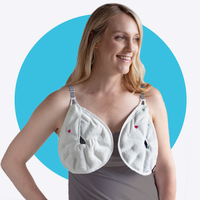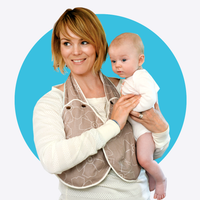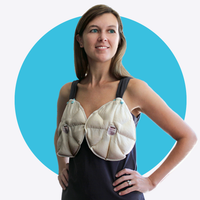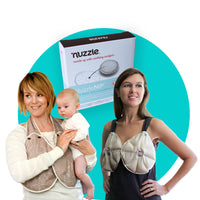6 Common Breastfeeding Issues: What to expect and how to prepare

Having a new baby is a momentous occasion. You can feel all the emotions, happiness, bliss, panic, fear, joy, peace, the works. Deciding to breastfeed is a personal choice and for new families, can be overwhelming. Between Google, Mommy groups, and well-meaning family and friends, new parents can find themselves with tons of information and no clear idea where to start. So, we’ve compiled a list of the six most common breastfeeding issues for new parents and how to navigate them.
Inability to Latch
One of the most common breastfeeding issues parents report is that they are not able to get baby to latch. For newborn babies, while latching can be instinctual, the mechanics of latching is new. Your boobs are new to them, just like your baby is new(ish) to you. They don’t know how to turn their heads or body. While it can seem instinctual to lay them on their backs and have them turn their heads on a breastfeeding pillow, try turning baby’s body in towards you. This alleviates any tension in the neck and makes feeding easier. There are several breastfeeding positions you can try that help with getting a good latch; finding a position that works for you and baby can take some figuring out. The most common breastfeeding positions are the Cradle, Cross Cradle, Laid Back or Reclining Positions, Side Lying, and the Football hold described below.
Cradle is the “classic” feeding position. Most frequently pictured and most often used. However, baby’s heads tend to wobble around on the arm, and it can be hard to maintain control of the head and body, while still feeding.
Cross Cradle provides good head control and can allow you to easily bring baby’s head and mouth to the breast. It can feel a little… weird, but it does allow for your hands to be free to help baby latch, grab a drink, the remote, or phone.
Laid back or Reclining position encourages baby to self-attach and allows you to rest and support your back. Younger infants may not be able to hold themselves in this position, or my roll, so this position requires the parent to provide stability and hold them in place.
Side lying is a great position for rest. Lying on your side with baby belly to chest with you can be super comfortable (if you’re comfortable with it). This is a great option if you bed share or are recovering from a C-Section or tearing. It can definitely take some getting used to, especially with younger, smaller infants. It can also be harder to get a good look and hands on the latch.
Football hold allows for great control of your baby’s head and allows you to get a full-on view of your little one’s mouth. It’s also helpful in avoiding C-Section incisions; your baby’s body is to your side, not across your midsection. This position may require some getting used to, and a pillow may be helpful.
OUCH! Painful Latch!Another commonly reported breastfeeding issue is that the latch hurts. While everyone’s pain threshold is different, latching should NOT be painful. Sure, there may be some discomfort, but pain from latching itself is a no-no. Remember; if you’re a new mom with a new baby, everyone is learning for the first time, and it takes practice and patience. If you experience painful latching, try a different breastfeeding position.
The first and most often overlooked key to fostering a successful, pain-free latch is to set the right mood, and that requires the right mindset. Give yourself a much-needed moment to relax. Then, get yourself into a comfortable position. A comfy spot on the couch or chair or some pillows for back support can make all the difference. Once you’re comfortable, it’s time to make sure baby is. You can position baby’s body by using different breastfeeding holds (cradle, cross cradle, football, laid back, side lying, or koala) and/or utilizing pillows.
Use your hands. Just like there are nursing holds for baby’s body, there are also ways to hold your breast/chest to help baby get a nice, deep latch.
Low Milk Supply
Many parents report low milk supply during different stages of their breastfeeding journey. As an IBCLC, what a lot of parents believe is low milk supply is actually perceived as insufficient milk supply. This is when parents think what they’re producing isn’t enough for their baby when it really is. Ensuring you are nursing on demand or as baby cues or pumping every 2-3 hours can help ensure your supply stays consistent. However, understand that pumping is only required if you are exclusively pumping or your baby is not latching/latching well.
Oversupply
On the opposite end of low supply is oversupply. This is when a parent produces more milk than their baby’s daily intake. This can seem like a great problem to have; however, oversupply can lead to baby refusing to latch, fussiness at the breast, throwing up, gas, frothy stools, clogged milk ducts, and mastitis. While parents can absolutely have a natural oversupply, it’s not recommended to induce one for the reasons listed above. If you find yourself or your baby struggling to navigate oversupply, talk to a lactation professional. Removing or decreasing feedings too soon can result in true low milk supply.
Engorgement
Engorgement is the swelling of breast tissue and is a super common issue in all moms. Parents can experience engorgement during pregnancy and, of course, during breastfeeding. It happens as the tissue in your breast/chest and armpits fill with fluid. Anyone who has ever experienced engorgement knows your first instinct is: please, make it stop! The second is: to pump it out. Before you grab your shiny new breast pump, consider hand expression and breast massage. Hand expression is much gentler than a pump and encourages milk to release without strong stimulation. Breast massage is gentle pressure that helps work out any tender or hard spots.
Pumping while engorged (if not exclusively pumping) can lead to…more engorgement, inducing oversupply, or mastitis.
Another way to find relief with engorgement is a cold compress. It helps reduce inflammation and can help with pain or discomfort. At-home remedies may include frozen cabbage leaves or ice packs but those can be awkward or require you to hold it in place. The NuzzlePUMP Pod is a nifty solution by that can hang from a hook-clasp nursing bra or be worn from a camisole or bra strap for hands-free convenience.
Weight Gain and Weight Loss
Everyone loves a fat baby. We’re obsessed with chubby cheeks and thick thighs. However, this cultural obsession can leave many new parents feeling lost and confused. “My sister in law’s baby was bigger at this age.” “My neighbor said their baby was eating this much by this time.” “The pediatrician said the weight isn’t where they want it to be.” It is absolutely normal for babies to lose weight after birth. According to the American Academy of Pediatrics, 5-10% weight loss is normal for a healthy full term baby. So, what does my pediatrician mean when they say the weight isn’t “where we’d like to see it?”
Healthy human milk fed infants generally gain 5-8 ounces per week during the first 4 months of life. World Health Organization (WHO) growth charts are used for human milk fed infants while Center for Disease Control (CDC) growth charts are used for formula feeding infants. If your baby is falling within these parameters, awesome! But, if they aren’t, it can be scary and confusing. If you experience weight gain or any breastfeeding related issues with your breastfed infant, work with your pediatrician and a Lactation Professional (sooner rather than later) to formulate a plan to get you back on track.






